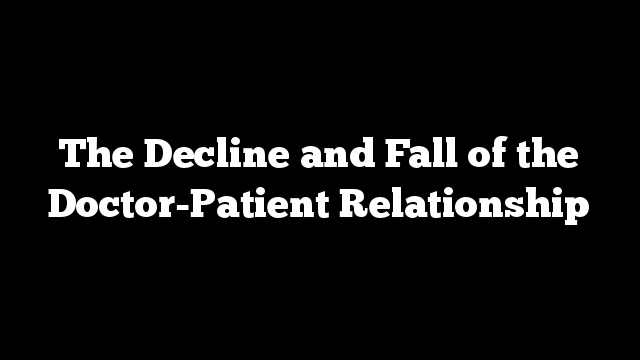 The physician-patient relationship is a bedrock of the U.S. health system. Strong relationships are associated with higher ratings for physicians and better outcomes for patients but there’s a catch.
The physician-patient relationship is a bedrock of the U.S. health system. Strong relationships are associated with higher ratings for physicians and better outcomes for patients but there’s a catch.
In Secretary of Health and Human Services’ Tom Price Senate confirmation and many times since, he has vowed his administration will seek to restore that relationship. But what patients associate with a strong relationship is increasingly at odds with how physicians think. And the gap between the two seems to be widening.
Background:
Per the American Medical Association, the physician-patient relationship is a formal or inferred relationship between a physician and a patient, which is established once the physician assumes or undertakes the medical care or treatment of a patient. It is a responsibility physicians don’t take lightly and most believe they do it well.
The physician-patient relationship has been widely studied. A framework developed by Ezekiel and Linda Manuel has been widely used to categorize the four roles physician play in these relationships: guardian, technical expert, counselor, and friend. In interacting with patients, physicians play all four. Researchers have linked a physician’s personality with their bedside manner. Surveys show most physicians lean toward a more paternalistic approach in dealing with patients and the majority think friendships with patients must be approached with caution. Academics have studied the dynamic between physicians and patients, observing that the physician is the ‘power’ figure in most. Studies have linked a physician known to have a prickly personality with more patient complaints and, in some specialties, a higher susceptibility to lawsuits. And physicians routinely compare notes among themselves about problem patients with whom interactions are routinely difficult.
Through the years, the American Medical Association and every major medical organization have opined consistently to the need for strong physician-patient relationships. Physicians understand their importance: they’re pragmatists. They understand that a pleasant bedside manner is not necessarily correlated to clinical competency and skillfulness but both are important. They are sensitive to impressions that their profession attracts smart people with big ego’s and a predisposition toward arrogance. And they recognize that changes in their environment are driving a wedge between how they practice and the expectations patients have for the relationship. Consider:
More physicians are now practicing in larger groups, and one third are employed in hospitals (MGMA). That means the clinical judgement of a clinician often is part of a larger scheme for managing patients consistently (to optimize clinical coordination) and efficiently (to maximize productivity and revenues). Peer reviews, utilization management and comparative effectiveness are now part of their lexicon.
Data about the quality of a physician’s care is increasingly accessible to patients from independent third-parties that sponsor report cards about physician outcomes, practice patterns and ratings by patients. It’s a growing irritant to physicians, especially those that believe the measures used are neither valid or reliable.
The science of medicine—what works, what doesn’t and for which patients—is increasingly accessible to patients seeking information about treatments that might not be recommended by their physician. The democratization of medical knowledge via social media and readily accessible clinical guidelines from reputable sources means patients have more questions and are often armed with inaccurate or harmful information.
Physician income pressures are mounting. Granted, their incomes remain healthy compared to the overall population ranging from 3:1 up to 20:1 but physicians face higher administrative costs and lower reimbursement from employers and insurers. There’s almost universal belief among physicians they’re fairly paid and palpable fear things are getting worse. And they react viscerally to the notion that physician greed is systemic.
And physicians understand that ratings by patients are here to stay. Patients expect to be able to compare the quality of medical care they receive just as they compare every other high-profile profession. And physicians know their ratings matter to payers like Medicare who penalize them for poor patient experience ratings.
Against this backdrop, most physicians believe their relationships with patients are less than ideal due to circumstances beyond their control. The majority think the profession is being compromised by external intrusions that limit their effectiveness as clinicians and compromise their relationships with patients. They want to spend more time with patients but recognize the gap between their wishes and reality is widening.
Patients see a gap, but their perspective is different. They see their physicians in positions of power and trust who are highly compensated and knowledgeable. They do not understand the complexities of modern medical practice nor do they believe them insurmountable. Their wish list is simple:
- Most patients trust their physicians’ judgement but want a second opinion for major treatments and decisions, and they pursue those on their own.
- Most want to learn more about their condition from sources that are evidence-based and independent.
- Most believe they should have complete access to their own medical record without cost or hassle.
- Most think their physicians should leverage online technologies to allow online scheduling, tele-visits, secure messaging and more. (Most practices permit online bill payment and little more).
- Most want their physicians to embrace alternative therapies and lifestyle interventions in their recommendations.
- All want their physician to tell them what a procedure or encounter will cost ahead of time to avoid surprises.
- All want to know their physician’s track record—outcomes, patient ratings, and more.
- All want their clinicians to disclose their conflicts of interest i.e. business relationships influence their referrals.
- All want their physicians to treat them with respect and listen better.
- All think their practices should provide better service that’s convenient, accessible and person-centered.Little wonder half of all patients say they are open to making a change. Most think physicians are focused on their own needs rather than theirs.
What’s Ahead for Physician-Patient Relationships?
Four trends will reshape physician-patient relationships:
Practice settings: Physicians will increasingly be affiliated with larger groups that position themselves around their depth, breadth, service, prices and reputation.
Financial Incentives: Physicians and patients will share financial risks associated with health insurance plans, and Medicare will penalize physicians that do not score at acceptable patient satisfaction levels. In other words, physicians will have an incentive to manage a patient relationship rather than accommodate visits and requests.
Data: An abundance of valid and reliable data will be available to consumers to compare the performance of their physicians about outcomes, practice patterns, financial relationships, patient experiences and costs.
Insurance Design: Patients will have more skin in the game. Employers are shifting financial responsibility to employees via high deductible plans; Medicaid is shifting to managed Medicaid and Medicare is encouraging alternative payment programs.
The combined impact of these means physician-patient relationships will be better coordinated, managed tightly and the basis for differentiating the performance of medical practices. Patients will migrate to practices that put their needs and values first.
The gap in the physician- patient relationship is widening. It’s clear patients want something quite different than they’re getting. Both perspectives are important and neither more than the other. So as Secretary Price and others espouse the centricity of the physician-patient relationship, it’s important it be understood objectively.
